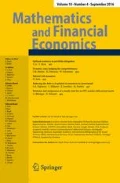Abstract
We study a CAPM economy with segmented financial markets and competitive arbitrageurs who link these markets. We show that the equilibrium of the arbitraged economy is Walrasian in the sense that it coincides with the equilibrium of an appropriately defined competitive economy with no arbitrageurs. This characterization serves to clarify the role that arbitrageurs play in integrating markets.
Similar content being viewed by others
Notes
While market fragmentation has accelerated in recent years, it has of course always been an important feature of the economic landscape. Allais [1] argued for a more realistic “economy of markets” in lieu of a “market economy”. In his Nobel speech he says: “\(\ldots \) I was led to discard the Walrasian general model of the market economy, characterized at any time, whether there be equilibrium or not, by a single price system, the same for all the operators,—a completely unrealistic hypothesis,—and to establish the theory of economic evolution and general equilibrium, of maximum efficiency, and of the foundations of economic calculus, on entirely new bases resting on \(\ldots \) a new model, the model of the economy of markets (in the plural)”.
We do not restrict state prices to be nonnegative, since we will have occasion to consider economies with no arbitrageurs later in the paper. In such economies there may be unexploited arbitrage opportunities, and hence negative state prices, in equilibrium. See Example 5.1.
Notice that each of the \(S\) terms that are summed up in the inner product must be less than or equal to zero, due to \(\mathbf{C1}\) and \(\mathbf{C2}\). Hence all of these terms must in fact be zero.
By uniqueness we mean that the equilibrium allocation and pricing functional on each exchange are unique. There may, of course, be multiple state-price deflators that induce the same equilibrium pricing functional.
Formally, \(p^A_s\) is the Lagrange multiplier associated with the arbitrageur’s no-default constraint in state \(s\).
Exactly the same proof goes through if we assume from the start that \(P^1=I\). Thus \(\bar{p}^{RP}\) is the (unique) WERP state-price deflator of the economy in which asset payoffs are the same as in the original economy except that markets are complete on exchange 1.
If markets are complete, \(p^{CM}\) is the unique solution to (22). If markets are incomplete, so that the common span \(\langle R\rangle \) is a strict subset of \(\mathbb R^S\), \(p^{CM}\) is still a solution, but it is not the only one. All solutions are of course equivalent to \(p^{CM}\).
References
Allais, M.: Les conditions de l’efficacité dans l’economie. Fourth International Seminar, Centro Studi e Ricerche su Problemi Economico-Sociali, Milan (1967)
Arrow, K., Hurwicz, L., Uzawa, H.: Constraint qualifications in maximization problems. Nav. Res. Logist. Q. 8(2), 175–191 (1961)
Cass, D., Siconolfi, P., Villanacci, A.: Generic regularity of competitive equilibria with restricted participation. J. Math. Econ. 36, 61–76 (2001)
Gromb, D., Vayanos, D.: Equilibrium and welfare in markets with financially constrained arbitrageurs. J. Financ. Econ. 66, 361–407 (2002)
Gromb, D., Vayanos, D.: Financially constrained arbitrage and cross-market contagion. Mimeo, London School of Economics (2009)
Gromb, D., Vayanos, D.: Limits of arbitrage: the state of the theory. Annu. Rev. Financ. Econ. 2, 251–275 (2010)
Polemarchakis, H., Siconolfi, P.: Generic existence of competitive equilibria with restricted participation. J. Math. Econ. 28(3), 289–311 (1997)
Rahi, R., Zigrand, J.-P.: Strategic financial innovation in segmented markets. Rev. Financ. Stud. 22(8), 2941–2971 (2009)
Zigrand, J.-P.: A general equilibrium analysis of strategic arbitrage. J. Math. Econ. 40(8), 923–952 (2004)
Zigrand, J.-P.: Endogenous market integration, manipulation and limits to arbitrage. J. Math. Econ. 42(3), 301–314 (2006)
Acknowledgments
We thank Bixuan Xu for research assistance, and an anonymous referee for insightful comments. We are grateful for financial support from the Systemic Research Centre, funded by the Economic and Social Research Council (ESRC), grant number ES/K002309/1.
Author information
Authors and Affiliations
Corresponding author
Rights and permissions
About this article
Cite this article
Rahi, R., Zigrand, JP. Walrasian foundations for equilibria in segmented markets. Math Finan Econ 8, 249–264 (2014). https://doi.org/10.1007/s11579-014-0114-4
Received:
Accepted:
Published:
Issue Date:
DOI: https://doi.org/10.1007/s11579-014-0114-4




